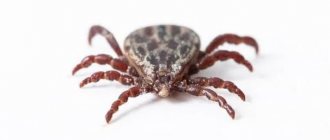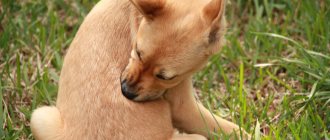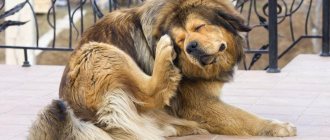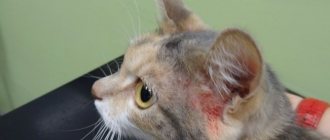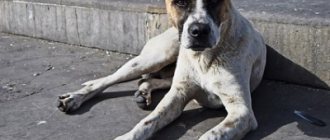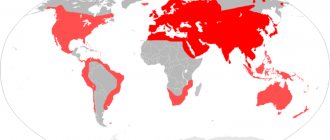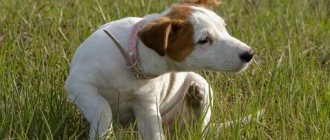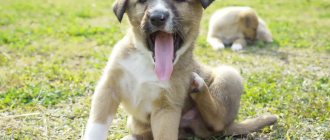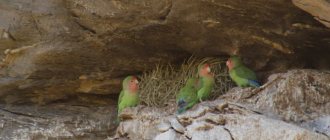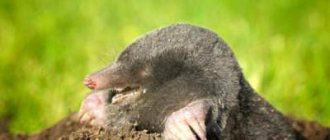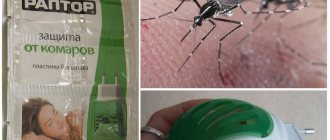Dogs chew their back paws quite often. This is an absolutely normal phenomenon: this is how animals, especially bitches, who are more clean, take care of themselves. By licking the paw pads, the spaces between the toes and the tail, they perform the usual hygienic procedure, getting rid of objects that interfere with walking - pieces of ice, snow, grass, and earth stuck to the fur.
The owner should be alerted to a change in the pet’s behavior when it doesn’t just lick its paws, but chews them until they bleed. Such a symptom may indicate the presence of a disease that has affected the dog’s body.
Main reasons
There are several reasons why a dog may begin to constantly chew and bite its back legs. Often this problem is caused by physiological factors and non-compliance with maintenance rules:
- poor-quality care - the owner does not clean the dog after walks, does not trim its nails regularly;
- contact with reagents that are sprinkled on ice in winter;
- unbalanced diet, lack of sufficient protein, vitamins and minerals in the diet;
- mechanical damage to the skin, abrasions and splinters.
These difficulties can be easily resolved on your own, without visiting a veterinary clinic. It is enough to monitor the pet’s condition and conduct regular examinations. The dog may begin to actively lick and chew its paws due to illness. A similar symptom is characteristic of the following diseases:
- food or contact allergies;
- neurosis (against the background of it, not only the paws are gnawing, but also the tail);
- subcutaneous mite, demodicosis;
- fungal infection;
- circulatory disorders;
- joint diseases, displacement of spinal discs;
- atopic dermatitis.
To accurately determine the cause, high-quality diagnostics are recommended. That is why it is important to contact a veterinarian in a timely manner and undergo a routine examination at least twice a year. If a dog bites its paws for a long time, it can result in tissue infection, inflammation and even necrosis.
Treatment of itching of various etiologies
Considering that itching in a dog is one of the symptoms of any disease, veterinary specialists, when treating your dog, will direct their main efforts to treating the specific disease that led, among other things, to the fact that your dog is itching.
Depending on the cause of the itching, veterinarians may use the following treatments:
- With increased sensitivity and irritability of the skin, dog owners should first of all normalize the feeding diet. The dog's diet must be balanced in nutrients and also contain the required amount of vitamins and minerals. In this case, it is necessary to exclude spices and fatty foods. To relieve skin irritation, use ointments and drops prescribed by a veterinarian; use an alcohol solution of tar prepared in a ratio of 1:10. During the course of treatment, owners should perform water procedures using soothing soap at least once a week. For the period of treatment, exclude meat from the diet.
- Treatment of food allergies in dogs should be based on providing the dog with a specific hypoallergenic diet. When treating a dog, in addition to completely eliminating the identified allergen, there is no need to give vitamin supplements, chewing toys, food high in carbohydrates, or treats. Antihistamines (diazolin, suprastin, diphenhydramine, tavegil, etc.) and glucocorticosteroids (dexamethasone, hydrocortisone, prednisolone, etc.) that reduce histamine levels and eliminate itching and swelling are used as symptomatic drugs.
- In the case when a dog’s itching is caused by the wet variety of ringworm, the drugs Mercurius and Sulfur are used for treatment. These medications must be used in accordance with the instructions. Additionally, to treat lichen, you can use bandages with medicinal ointments and water procedures with creolin soap. When carrying out treatment, we exclude meat products and potatoes from the diet.
- If itching caused by lichen sicca in a dog, in order to prevent infection of other animals, you will need to isolate the sick dog from them. The dog should be bathed and washed with soothing soap as often as possible, and before bedtime, the affected areas of the skin should be treated with linseed oil. Phosphorus 3 or Dulcamara 3 is added to the dog's food, no more than 5 drops per day.
Why does a dog chew its tail?
Many people, seeing such a spectacle, think that it is funny, and the dog is just playing. Indeed, this often happens in puppies who are not fully aware of their body parts. However, what to do if this happens to an adult dog? In this case, you need to carefully monitor your pet. Most often this becomes a sign of the presence of some kind of pathology.
Typically, a dog may chew its tail for several reasons:
- Parasites
- Inflammation of the paraanal glands
- Eczema or ringworm
- Tail injuries
- Neurosis and psychological trauma
- Boredom
- Allergy
- Poor nutrition
The dog is chewing his tail
How to recognize the problem?
Caring for your paws is a natural hygiene procedure for any dog. A deviation is considered if the desire to lick the limbs becomes obsessive, the animal often gnaws the pads for a long time. To detect the problem, you should inspect your dog's paws regularly. They should be free of persistent dirt, signs of injury and other mechanical damage. The following signs are unacceptable:
- presence of blood;
- inflamed and weeping areas of the skin;
- dry crusts on the pads;
- traces of alopecia (hair loss);
- change in dog behavior;
- refusal of food, games.
Be sure to pay attention to any deviations in your pet’s usual behavior. You should consult a doctor if your dog becomes aggressive or apathetic (when he chews), refuses food and even his favorite treats. The problem can be especially dangerous if the pet begins to growl and grin, and does not allow him to approach him during the next licking of his paws.
Inspection of a dog's paws should be done carefully. Even the slightest touch of the paws can be painful and uncomfortable for the dog. You need to be careful when touching the paws of older pets - the problem may arise due to age-related joint diseases.
Photo: thehappypuppysite.com
Treatment and treatment at home
In the early stages, when there is no severe tissue damage in the area of the pads, treatment can be carried out at home. The main rule is high-quality care for your pet’s paws, as well as timely treatment when gnawing. Algorithm of actions:
- Carefully examine the area that the dog is licking (pads, fur on the bend of the limb, fingers).
- Remove any visible dirt with a cotton pad soaked in clean water.
- Trim off excess hair and shorten the length of nails if possible.
- Treat the skin with any antiseptic solution (Miramistin, Chlorhexidine, Furacilin).
- If there is bleeding, apply a cotton pad with hydrogen peroxide and secure it with a special adhesive bandage. It is recommended to additionally wear a muzzle or an Elizabethan collar.
It is recommended to carry out treatment after each walk, at least 2 times a day. If there are no visible improvements within 2-3 days, then contact a veterinary clinic.
A dog chews its tail: treatment for fleas
The fact is that in the area where the body transitions to the tail, there are a large number of sebaceous glands that attract parasites. It is in this area, as well as near the ears, that fleas can be found. Accordingly, they are active there and can bite the pet. This is why the dog chases its tail in an attempt to fight off parasites.
It sometimes happens that the dog chews this area until it bleeds. The easiest way to get rid of it is to use special shampoos. Fortunately, there are now a huge number of remedies for fleas and other parasites in veterinary pharmacies. But, try not to wait for parasites to appear in your dog, but try to prevent their occurrence. That is, it is necessary to wash the dog with flea shampoo for prevention. Once you remove the parasites, your dog will most likely stop chewing his tail.
List of flea remedies:
- Bars - antiparasitic drops for dogs
- Actofit - bioinsecticide
- Hartz Drops 3in1 against fleas and ticks for dogs
- Repellent spray Outdoor with aloe vera for dogs
- Bayer Advantix anti-parasite drops for dogs
Beautiful pet
Itchy mites in a dog
The dog is itching due to a number of mites belonging to the genus Otodectes, Demodex, Sarcoptes. The clinical picture for them is approximately the same. Although there are differences in the localization of the pathological process (ears, body) and the form of inflammation. The same medications are used for treatment, although the form and method of administration may differ.
Ear scabies is called otodectosis - a common parasitic disease caused by a small (up to 0.5 mm) mite that penetrates the mucous membrane of the inner surface of the auricle. The disease is widespread and puppies are most susceptible. Spread by wild and stray animals.
Itching is caused by the vital activity of the mite - it tears the skin with its paws and enhances the inflammatory reaction with metabolic products. The skin becomes inflamed again when the dog scratches it with its claws. The disease is complicated by secondary infection.
Clinical picture:
- severe itching and abrasions on the ears and head;
- the dog is constantly caught scratching - the affected areas do not stop itching;
- hair loss;
- discharge from the ear;
- the temperature is increased by 1-2 degrees in severe forms;
- The final diagnosis is made when parasites are detected.
Specific therapy is cleaning the ear canal from crusts and pus. It is recommended to pre-moisten the crusts with furatsilin and rivanol. The administration of drugs without preliminary purification does not give a positive effect - the active substance cannot affect parasites through the crusts. In addition to special agents, anti-inflammatory drugs and antibiotics are used for bacterial complications.
With sarcoptic mange, the pathology is much more pronounced, since this form of parasites penetrates the skin, which is why the dog itches especially badly, causing great injury to itself. Young and weakened dogs are most susceptible. The disease most often spreads through direct contact with an infected animal.
The pathology often begins with damage to the dog’s muzzle, and gradually the area of itching and baldness spreads to other parts of the body. The animal develops plaque and dandruff on its skin. The pet vigorously scratches areas of the skin that are constantly inflamed. Crusts and purulent inflammation form on them. Prolonged course leads to exhaustion and death is possible.
Dog treatment:
- skin cleansing - bathing with special soaps and shampoos;
- hair is removed around the affected areas;
- wounds are treated with antiseptic and anti-inflammatory ointments (Vishnevsky, ichthyol, tetracycline);
- special anti-tick agents are used - locally and generally;
- general symptomatic and compensatory therapy.
A similar clinical picture is observed with canine demodicosis, but it also involves damage to internal organs. There are pustular (vesicles form on the skin in which parasites accumulate), scaly and general forms. The dog's hair falls out and areas of the skin become dry. Abscesses and areas of severe inflammation form on the skin. Ticks can penetrate blood vessels and spread into the internal organs of the animal. Diagnosis is made by microscopy of skin scrapings.
Anti-tick medications:
- Ivermectin, Aversect are injectable drugs that allow you to fight the generalized form. Be sure to use it to prevent the spread of ticks throughout the body, since local treatment cannot completely cover the parasites;
- ASD, marasasd and other derivatives;
- bolfo – shampoos, drops, aerosols;
- pyrethroid drugs.
Ticks continuously develop resistance to drugs, so it is recommended to constantly change treatment products, especially for preventive purposes. Parasites should also be destroyed in the environment - cleaning, disinfection of kennels and beds. It is recommended to use collars and drops on the withers to prevent infection.
When to contact the clinic?
You should consult a doctor if your dog chews its paws hard and often until it bleeds, or if there are signs of tissue damage. In this situation, early treatment can prevent dangerous complications, so if you cannot cope with the problem on your own, you need to urgently make an appointment. One of the main purposes of the treatment is diagnostics, which allows us to identify the reason why the dog chews itself. Basic research methods:
- visual examination, collection of the dog’s medical history through an interview with the owner;
- blood chemistry;
- stool analysis;
- microscopic examination of skin scrapings.
The choice of the optimal solution is based on the diagnostic results and the dog’s well-being. Depending on the reasons that caused the problem with the paws, drug therapy, physiotherapy, changes in the rules of maintenance and care may be prescribed. The main tactics for treating dog scratching is to identify the reasons why the dog chews its paws, eliminate symptoms and enhance recovery, and stimulate the animal’s immunity.
Photo: naturaldogcompany.com
Neurosis
This is a psycho-emotional disorder that leads to behavioral disturbances and obsessive manifestations. If the dog itches and chews its paws due to neurosis, the following conditions are recommended:
- emotional and physical peace of the pet;
- restrictions on walks and exercise;
- creating a comfortable and safe place in the house;
- correction of diet, inclusion of vitamins and minerals in the menu;
- increasing time for games, communication and contact with your pet.
Recovery can take a long time; during treatment you should provide the dog with care and affection, which is important for its health. Regularly inspect and treat paws.
Fungal infection
A common reason why a dog begins to actively lick its paws. Against the background of the disease, severe scratching of the skin, bruising and dermatological manifestations are observed. Treatment tactics:
- The doctor selects an antipruritic and antifungal drug (Mycozoral, Clotrimazole).
- Regular treatment of wounds with an antiseptic is prescribed
- Paws should be thoroughly dried after each walk, and prolonged exposure to the street should be avoided.
- Systematic washing of the limbs with a special detergent (Nizoral, Imaverol).
In advanced forms, tablets or injections for intramuscular administration are recommended. Against the background of a fungus, it is important not only to fight the symptoms, but also to strengthen the immune system. That is why it is important to balance the diet and give additional vitamin supplements.
Allergy
Among other problems, it occurs frequently. Allergic manifestations are quickly relieved with medications, but it is important to identify the source of irritation. This could be a food product, flower dust, flavored additives and other external factors. It is recommended to take an allergen test in order to adjust the dog’s diet and lifestyle. If the cause of the pathology was food, then completely exclude this component from the pet’s daily menu.
Photo: flickr.com
Professional diagnosis of itchy skin
Skin itching is a clinical sign not only of diseases, but also of specific conditions of the pet’s body. Especially if the cat or dog is itching, but there are no fleas and the skin is clean. In this case, the appearance of itching may be associated with stress, mental disorders, nervous or hormonal disorders, peculiarities of keratinization of the epidermis (upper layer of skin) or other reasons. Therefore, the veterinarian is faced with a difficult task - the specialist will have to find out why a dog or cat is itching if it does not have fleas and prescribe adequate treatment for the pet. To solve it, a comprehensive diagnosis is used, each stage of which helps to establish the true cause of itching.
- First, skin scrapings are taken from the pet to identify mites and a trial antiparasitic treatment is prescribed.
- Then a cytological examination and (or) bacteriological culture is performed, which helps to identify fungal and bacterial infections.
- Dietary nutrition is prescribed to exclude food allergies, etc.
If a dog or cat is itching, but there are no fleas, then the veterinarian must study the pet’s medical history - the presence of hereditary diseases, living conditions, hygiene features, the influence of traumatic and other factors. And if a puppy or kitten itches, but there are no fleas, then not only the baby’s body, but also the medical history of its parents must be examined.
Paw care after a walk
Proper care of your pet after a walk is a basic method of prevention to prevent the dog from gnawing its paws. Allows you to avoid complications from mechanical damage (wounds, abrasions, splinters), infections and the consequences of contact with reagents in winter.
After each visit to the street, paws should be washed with clean running water, and if necessary, use a special shampoo for dogs. Recently, paw washers have become very popular - small jars with brushes inside that are easy to use for cleaning dirt for any breed. After hygiene procedures, carefully examine the paw pads and fur. There should be no traces of dirt, blood or mechanical objects.
Causes of wool chewing
When you notice for several days that your pet is still actively itching and tearing its skin, you should immediately go to the veterinarian, since such symptoms may indicate chronic diseases. Therefore, in this article we will look at why a dog chews its own fur and what the owner can do to eliminate this problem. In a word, there can be a huge number of reasons.
Make sure that your dog does not break the skin, as infection can easily get into the affected areas. The selection of medications and the effectiveness of treatment depend on a well-defined factor. Here are the most popular reasons for active scratching in an animal:
1. The root cause is getting rid of fleas, since the dog experiences discomfort and a constant feeling of itching for a long time. This causes significant damage to the skin.
2. An allergic response occurs due to powerful irritation. When a dog chews out hair near its tail, this indicates contamination or inflammation of the anal glands.
3. Atopic dermatitis - the disease is characterized by the appearance of itching, which is considered the result of the body’s reaction to various allergens. For example, such allergy triggers can be a high level of dust at home, and in addition the presence of the tiniest parasites - mites. Typically, animals suffering from this type of allergy will rapidly scratch their head, ear and muzzle. This reaction can progress in the summer, since immediately at this time the number of molds and pollen increases rapidly.
4. Allergic response to insect bites. This type of allergy occurs much less frequently than other types. However, if the pet is exposed to it, it scratches and gnaws the affected areas.
5.A severe form of wet skin disease, which refers to a bacterial infection. This type of dermatitis causes redness and can cause severe irritation. As a result, your pet will begin to scratch and chew on areas that are very itchy.
6. Due to subcutaneous mites, the dog begins to gnaw the hair on the paws and face, which are considered the main places where the insect is localized. In this case, the animal can scratch these areas until blood forms. Another feature of this skin lesion is baldness.
7.Eczema is characterized by severe itching, which forces the dog to scratch itself vigorously with both claws and teeth. With eczema, bleeding wounds may occur on the body of dogs, especially short-haired dogs. The sides, base of the tail, armpits, and the area behind the ears suffer most from this pathology.
Other factors causing itching
Owners often begin to panic, suspecting that the dog has serious illnesses, for example, chronic atopic dermatitis. However, it is necessary to understand that a factor in the appearance of discomfort in this area can be both the above-mentioned diseases, but also the following points of influence:
Poor position of the nail plates. Often, owners lose sight of the need to trim their pet's claws, which leads to their uncontrolled growth and, as a result, significant discomfort in the animal. In most cases, the dog may even move strangely when walking, as well as vigorously bite the affected areas.
Dirt between the toes of an animal. This mainly applies to the owner of the dog and his careless care or lack thereof. Over time, when many pellets of dirt have accumulated, the dog itself tries to get rid of them, while gnawing these areas of dirt.
- Damage to paw pads. Skin injury can be caused by contact with the reagent or sliding on asphalt.
- In most situations, the animal gnaws at its paws, or the dog gnaws out the fur on its thighs, which may indicate the appearance of a subcutaneous mite.
- Improper nutrition, which is characterized by an excess or lack of vitamins.
- Neurosis. Sometimes dogs suffer from this disease. Therefore, try to avoid any situations in your pet’s life so as not to disturb his psyche.
Diaper rash
Such a nuisance as diaper rash occurs mainly in long-haired breeds due to the fact that a fairly large amount of hair grows on the paws and between the toes.
Long-haired dogs include Dachshund, Spaniel, Chihuahua, Beagle, Weimaraner, Russian Toy Terrier, Hungarian Vizsla, Shih Tzu, Caucasian Shepherd, Pekingese, and German Shepherd.
Poorly dried hair after bathing and lack of ventilation are a good breeding ground for bad microflora.
Avoiding this problem will not be difficult. It is enough to ensure that very long hair does not grow on the paws, and cut it off in a timely manner, and after bathing, dry the area between the toes well with a hairdryer.
Did you know? Dogs can sweat too, just like humans. Only their sweat glands are concentrated not in the armpits, but on the pads of the fingers.
These simple measures will keep your skin dry and eliminate diaper rash.
How to protect paws from the reagent?
In cities, streets in winter are sprinkled with a special reagent that thins the ice. It can lead to burns and severe pain on the paws. Rules on how to avoid consequences when coming into contact with salt while walking:
- Choose shoes depending on the size of your paws. Get used to wearing it.
- If it is not possible to wear shoes every time you visit the street in winter, treat the pads with regular Vaseline - it creates a protective layer and relieves itching when exposed.
- Before starting the walk, you can lubricate it with veterinary wax. It will protect the delicate skin of the pads from contact with the reagent.
If the skin of the paws is still corroded, and the dog constantly gnaws on them, proper treatment is required. First, the skin must be washed and an antiseptic applied. After it dries, use anti-inflammatory ointment (Levomekol, Iruksovetin). Wrap severe damage with a sterile bandage. At night, the limbs can be washed with a weak solution of chamomile.
Photo; bedandbiscuitaustin.com
Contact dermatitis
Contact dermatitis is a specific reaction of the epidermis to the action of an irritant. It can be caused by household chemicals, dog washes, and external preparations. Contact dermatitis is an inflammation of the epidermis accompanied by swelling and itching. The symptoms are in many ways similar to skin allergies, but with allergies, an immunopathological process develops, and with dermatitis, irritation and inflammation develop.
Recognizing dermatitis is quite simple, since it appears immediately after contact with an irritating substance. The owner’s actions should be aimed at cleansing the animal’s skin of any remnants of the irritant.
Apply a cool compress to reduce swelling and itching. For severe inflammation, anti-inflammatory ointments or corticosteroids can be used. Such drugs should be prescribed by a doctor after examination.
The dog bites its hind legs and chews its tail - what to do?
Oddly enough, dogs also have nervous breakdowns, just like people. This often happens after moving or experiencing some kind of fear, perhaps fright. Think about it: maybe someone scared your pet, hit him, or he got into a fight with other dogs in the yard and was seriously injured. Quite often, the reasons for chewing the tail are precisely mental illnesses and increased excitability.
Adviсe:
- Try to show your dog that chewing his tail is bad. Such manipulations are carried out only if you are sure that the dog does not suffer from any infection, his anal glands are clean, there are no fleas, ringworm, or allergies. In this case, the reason is precisely in the dog’s psyche. You need to buy a rattle or just put some pebbles in a tin and seal it with tape.
- As soon as the dog starts chewing his tail, you need to throw this tin can to scare him. Thus, a conditioned reflex will arise that will indicate that chewing your tail is bad. This way, if he chews his tail, he will get scared or get hit by a tin can.
- The same manipulation must be done with a baby rattle. To prevent the tail from being chewed until it bleeds, it is necessary to put a special cone-shaped collar on the dog. This way he simply won't be able to touch his tail.
- Often, owners simply put pants on the dog and hide the tail so that the pet cannot reach it. If the dog reaches the tail, it is necessary to coat the wound with chloramphenicol. This ointment has a very bitter taste, so the dog will have a conditioned reflex that if he chews the tail, there will be a bitter taste in his mouth. The dog sedative Fitex has proven itself quite well. This is a drug that relaxes dogs, making them calmer.
At the veterinarian's appointment
Mental disorder is a rare but painful disease
Your dog may look completely healthy, but suddenly has a seizure - the animal attacks its own limb. Fierce aggression. The dog seems to mistake its own leg for an enemy.
This white dog named Orivol appears to be completely healthy. She is happy and plays with her owner. Only red blood spots indicate a problem. Suddenly the dog starts biting his own leg. If you do not intervene, the pet will chew the skin until it bleeds.
Veterinary examinations did not find any abnormalities in this pet. At the same time, the owner reported that she managed to save the dog from the former owner, who constantly beat her. Perhaps the dog has developed post-traumatic syndrome and periodically perceives its own limb as an enemy.
The experiment shows that most often a dog begins to bite itself when a person next to it has something in their hands. If you remove the object, the pet usually stops showing aggression. Aggression is also observed when touching the dog's stomach.
Similar markers of the problem can be found in every case of mental illness in a pet. But for this you need to work with your dog.
It is worth noting that such mental disorders do not only occur in dogs. Cats also often show aggression towards their limbs. And a person experiences similar deviations when he stops perceiving his arms or legs as part of himself.
But such behavior in dogs is often completely unrelated to the psyche.
Nail trimming
Unlike cats, dogs cannot shorten their toenails on their own - they have a dense structure, a large number of nerve endings and blood vessels. Long claws cause a lot of discomfort, so the animal tries in every possible way to get rid of them - it starts gnawing and licking its paws. It is important to get a haircut every 1-2 months, to get used to the procedure. Step-by-step algorithm for processing claws:
- Secure the dog in a standing or lying position. If necessary, wear a muzzle.
- Pull back the fur and use a flashlight to illuminate the claw (bright light allows you to see the vessels inside).
- Using special pliers, cut off the edge of the nail bed (collagen layer) - it has no nerves or capillaries.
If bleeding does occur, apply a cotton pad soaked in hydrogen peroxide. If there is a sharp cut left, polish it with a nail file. During the procedure, you should not make sudden movements and praise the dog after each nail trimmed. At the end of the work, be sure to treat your pet with a treat to associate the haircut with positive emotions. Manipulation can be combined with shortening the hair, which is especially important for long-haired breeds and hunting dogs.
Psyche
Unfortunately, many dog owners leave their dogs at home for long periods of time. At the same time, the animal experiences stress, suffers from loneliness and boredom.
They find salvation in their own paws, because a monotonous task is distracting, and thus waiting for the owner to arrive becomes less tiring for them. Why go far, let's remember tips for getting rid of stress for people: reading, knitting, cross-stitching, drawing, etc. These are all monotonous activities that force you to concentrate and thereby relieve stress.
Only dogs can’t do anything like that, so they came up with this type of activity. It is also a unique way to attract attention. After all, when you see your pet chewing its paw, you will immediately begin to say something displeased to him, but he is only glad to have at least some communication from you.
Therefore, do not neglect your dog, but spend more time with it.
Briefly about the main thing
- Dogs lick their back and front paws for hygienic purposes. In this way they get rid of dirt and objects left between the pads after walks.
- If the procedure becomes intrusive, severe scratching, redness, signs of hair loss and bruising appear on the limbs, you should contact a veterinarian.
- The main reasons why a dog chews its paws are neurosis, allergies, mechanical damage to the pads, infection, and exposure to reagents.
- For prevention, you should wash your pet after every walk, remove excess hair and trim its nails. In winter, wear boots or use protective wax when walking.
Have you ever experienced your dog chewing his paws? Share in the comments what to do in such a situation, how to help your pet.
Did you like the article? Share it with your friends on social media. networks. This will help them get useful information and support our project.
Why does a dog itch if there are no fleas?
Itching in pets can develop due to various factors. These include allergic reactions, ectoparasites, skin diseases, as well as the consequences of stress and lack of vitamins. In all the presented cases, the skin of pets is very itchy; this condition can be accompanied by the formation of wounds, the appearance of bald patches, and rashes.
In some pathologies, itching is accompanied by severe pain. If the owners notice that the puppy is whining, has lost his appetite, and constantly bites himself even after the next flea treatment, they need to take him for an unscheduled examination. Until they identify the cause of such symptoms and fully treat the animal, the signs of the disease will not disappear.
Ectoparasites
Fleas are not the only parasites that can plague our pets. In addition to these, dogs can also develop:
- Subcutaneous mites. Horny skin scales are consumed. They provoke demodicosis and lay their eggs in hair follicles. They most often affect individuals with low immunity. They can cause not only severe itching, but also baldness.
- Lice. They feed on the animal's blood and lay eggs in the pet's fur. Their presence is indicated by bloody wounds near the pet’s ears and neck.
- Ixodid ticks. They carry borreliosis and encephalitis. They can attack an animal while walking in parks and squares, most often affecting the neck and the area behind the ears. Ixodid tick bites cause a severe allergic reaction.
- Vlaseaters. They feed on skin scales. They provoke hair loss and the appearance of a rash on the skin. They settle mainly along the spinal column, on the head.
- Gamasic parasites. I attack the dog's torso. They are rare, as cats and rodents are more often chosen as victims.
- Scabies arachnids. They give painful bites that can cause severe stress and muscle spasms in the pet.
- Mosquitoes and mosquitoes. These insects bite dogs mainly at night. Some breeds have severe allergies to their saliva, which leads to itching and severe swelling.
To identify parasites, you need to examine your pet's skin and fur.
If you notice a rash, small insects, or small scales that sit tightly on the fur, contact your veterinarian. There is a high probability of infection with fleas, lice, and ticks. It is impossible to remove parasites without the help of specialists. To alleviate the condition of a pet that itches all the time, you should do the following:
- Treat it with a special anti-parasitic shampoo or spray (Bars, Frontline).
- Wash your dog’s favorite toys, replace your pet’s bowl with a new one. Treat upholstered furniture, carpet, curtains with special products.
- Buy a flea collar and put it on your pet. It can be used not only for treatment, but also as a preventive measure to prevent the dog from picking up parasites from other animals on the street or at a party.
Don't expect to get rid of ectoparasites in one go. Their eggs may remain in the house, from which a new generation of insects will hatch. To eliminate them all, be sure to re-treat both your pet and your home every two weeks. Use proven medications for this purpose and follow all veterinarian recommendations on this issue.
Allergy
Itching can appear in dogs as a result of an atypical immune response of the body to exposure to a particular substance. In case of allergic reactions to an irritant, this symptom will be accompanied by sneezing, swelling of the mucous membrane, and “splashing”, indicating a dry throat in the pet. In some cases, the puppy may experience hair loss, a rash, and an increase in temperature.
The following allergens can provoke an abnormal reaction of the body:
- Chemical elements. Air fresheners, bowl materials, animal bedding, medications. It is worth paying attention to this factor if the dog’s face or paws are very itchy after the drops. It is possible that the selected medication is not suitable for her.
- Food allergens. Dyes, flavor stabilizers, individual products. Beef, horse meat, and milk can cause an abnormal reaction in the body. Sometimes it can manifest itself in food that the pet previously ate with pleasure.
- Bites of parasites - fleas, ticks.
An allergy to a certain substance can be suspected if your pet's skin itches, but there is no dandruff. Dog breeders should remember that this pathology is practically untreatable by modern veterinary methods. He should take care of the special conditions for keeping his animal so that it can feel comfortable in the future.
Skin diseases
Itching in a pet can be caused by dermatological pathologies. These include:
- Lichen. This is a disease of a fungal nature, in which a pet develops a round bald patch, and small blisters with colorless greed appear on the skin along its perimeter, which burst and spread the infection to neighboring tissues. A dog of any breed can become infected with lichen, including Chihuahuas, Shepherds, and Labradors. The infection can be transmitted to a pet from a cat or any other animal. Sometimes fungal spores get onto the pet’s skin from a person’s clothing; they provoke this disease if they settle on wounds or chafing from the collar.
- Trichophytosis. The symptoms of this disease are similar to ringworm. However, this fungal infection affects not only the skin, but also deeper tissues, which is why the dog develops wet wounds on the body, from which pus and ichor are released. Requires long-term systemic treatment.
- Dermatitis of inflammatory etiology. Found in pugs and chow chows. It appears as redness and increased moisture in the folds of the skin.
Less common in dogs are eczema, scab, and atopic dermatitis (it is hereditary). Animals with such diseases are prescribed local and general antimycotic drugs. It is recommended to isolate them from people and animals during treatment. If the pet's condition is assessed as severe, he may be prescribed antibacterial therapy.
Disruption of the sebaceous glands
This pathology is rare. It develops against the background of a change in the consistency of secretory fluid or feces. Because of this, the sebaceous glands located near the dog’s anus become blocked. The development of such a disease is indicated by a number of symptoms: the appearance of itching, dark spots on the affected area of the skin, small bald patches around the tail.
Manifestations of the disease include oily seborrhea and sticky fur. A pet suffering from this pathology chews its tail, rides on its butt, and licks its butt. If he does this regularly, he will develop bald spots on the affected area of the body.
This problem cannot be completely eliminated at home. To alleviate the animal’s condition, you need to use specialized shampoos that regulate the function of the glands.
Stress
Constant mental and physical stress can also cause mange in a dog, even if he does not have mites. The following factors can provoke the development of pathology:
- improperly organized games with a pet;
- family conflicts witnessed by the animal;
- fear caused by loud sounds, sudden movements.
In some cases, a dog's scabies appeared after a visit to the veterinarian. It could be triggered by the unpleasant smell of medications or procedures that are uncomfortable for the pet.
Itching caused by stress usually goes away in the dog after the irritating factor is eliminated. If the symptom is observed in the animal for a long time, he is prescribed sedatives and regular games in the fresh air. To quickly recover, the animal needs to receive positive emotions.
Allergy
One of the most common reasons for this behavior is allergies. And if we say in scientific language, then atopic dermatitis. It is characterized by an inflammatory process in the skin that occurs due to environmental irritants. This disease is genetic and usually makes itself felt in the first years of a dog's life. During an exacerbation, the dog constantly licks the hair on its paws right down to the skin, and it can also bite them.
The area between the toes and the pads of the paws become very inflamed and red. This is due to very severe skin itching. Liquid snot may also appear, and the eyes may become sour.
If you have such symptoms, you should not put off going to the veterinarian, because finding out the cause of the allergy is not so easy. Therefore, the sooner you go to the veterinary clinic, the faster your pet will get rid of the unpleasant itching on its paws.
Allergic reactions
Itchy skin occurs due to food allergies. No animal is immune from such a reaction. It is quite simple to distinguish an allergy from other pathologies, because its symptoms appear several hours after consuming allergenic foods.
Characteristic symptoms:
- skin itching;
- discharge from the ears and nose;
- lethargy and drowsiness;
- refusal of food.
In addition to food, allergies with dermatological manifestations can occur in response to parasites (intolerance to flea saliva) or taking medications.
The owner's actions in case of allergies: interrupt contact with the irritant, give the animal a quarter of a tablet of any antihistamine, apply a cool compress to reduce itching.
